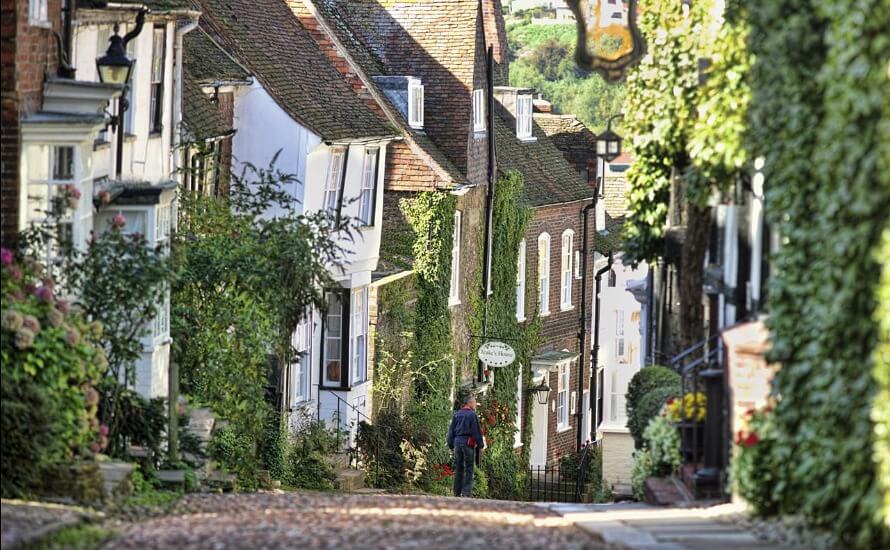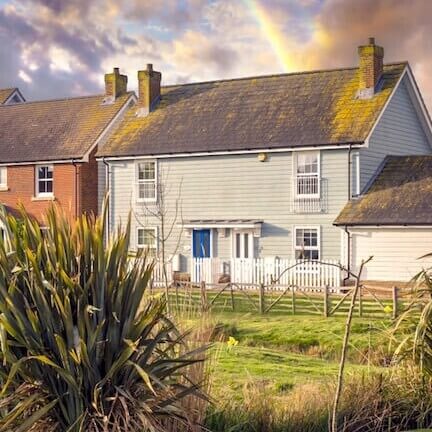From the dramatic chalk cliffs of the Seven Sisters to the wild heathlands of Ashdown Forest, Sussex holds some of Britain’s most captivating landscapes within its borders. This ancient county, where the South Downs meet the English Channel, offers visitors an extraordinary variety of visual treasures throughout the seasons.
Whether you’re drawn to historical architecture, coastal drama, or pastoral scenes, a holiday in Sussex provides endless opportunities for compelling imagery. This comprehensive guide will take you through the best locations across East and West Sussex, helping you capture the essence of this remarkable county.
Camber Sands
A vast sandy expanse of coastline that sits at the easternmost end of East Sussex, Camber Sands is a beautiful part of southeast England and a must if you’re visiting Sussex. It’s an ideal spot for dog walking or family-friendly holidays, especially if you’re visiting during the summer.
The dramatic system of dunes – among the largest on the south coast – creates an ever-shifting landscape of light and shadow that photographers can capture throughout the day. During low tide, the beach reveals miles of rippled sand, creating natural patterns that are particularly striking when photographed in the soft morning light or during sunset.

Dungeness
Dungeness offers a hauntingly beautiful landscape that feels almost otherworldly, making it a photographer’s paradise. This vast shingle beach creates a stark, desert-like environment where abandoned fishing boats and weathered wooden huts dot the horizon.
The iconic nuclear power station looms in the background, providing a striking industrial contrast to the natural elements, while Derek Jarman’s famous cottage garden adds splashes of colour against the monochromatic landscape. Wildlife photographers will find particular joy in capturing the diverse bird species that make this nature reserve their home too, especially during migration seasons.
Seven Sisters Country Park
The Seven Sisters offer some of the most dramatic coastal views in Britain. The stark white chalk cliffs create a stunning contrast against blue skies and green grasslands, with each of the seven peaks – from Haven Brow to Went Hill Brow – providing different angles and perspectives. The meandering Cuckmere River adds another dimension to landscape compositions, particularly when photographed from elevated positions where its serpentine curves create leading lines through the frame.
Rye
Perched atop a hill overlooking Romney Marsh, Rye presents a perfectly preserved medieval townscape that seems frozen in time. The town’s cobbled Mermaid Street, with its tilting half-timbered houses and ancient inns, offers endlessly photogenic scenes, particularly during golden hour when warm light covers the weathered buildings. The view from St. Mary’s Church tower provides spectacular panoramic vistas across the red-tiled rooftops to the surrounding countryside and distant coastline.
Photographers will find rich opportunities in capturing the morning mist rising over the nearby marshes, the changing light on the ancient town walls, and the picturesque harbour where fishing boats rest at low tide, and the narrow passages and secret corners of the town reveal new perspectives with each visit.

Ashdown Forest
This enchanting landscape offers photographers a perfect blend of open heathland and ancient woodland, famously inspiring A.A. Milne’s Winnie the Pooh stories. The viewpoint at Gills Lap provides spectacular panoramic shots, particularly during misty mornings when the sun breaks through the fog to illuminate the rolling countryside. The iconic Pooh Bridge offers charming views, framed by overhanging trees or bathed in the golden light of early morning.
Cissbury Ring
This ancient hill fort provides commanding 360-degree views that are particularly spectacular during the golden and blue hours. The Iron Age earthworks create natural leading lines that can be incorporated into your photos, while the site’s elevated position makes it perfect for capturing dramatic weather systems rolling in from the coast.
There’s plenty of hiking and biking opportunities here, and if you’re visiting with children, they’ll have a great time ticking off some of the tasks on the ‘50 things to do before you’re 11 ¾’ challenge, such as flying a kite, rolling down the hills or looking for insects and birds.
Black Down Hill
The highest point in Sussex offers an extraordinary variety of subjects, from sweeping heathland vistas to intimate woodland scenes. The purple heather and wavy hair grass create beautiful vistas, particularly during the golden hour when backlit by the setting sun. Head to this area on a summer’s evening to enjoy stargazing from the highest point in the South Downs National Park or go horse riding along the network of bridleways running through this area.
Best Times to Visit
Timing the perfect shot varies significantly across Sussex’s diverse locations. Coastal sites often work best at dawn, when the light is soft and crowds are absent, while gardens typically offer optimal conditions in early morning or late afternoon. The South Downs excel in side-lighting conditions, particularly golden hour. But remember to take seasonal considerations into account too, such as spring wildflowers, summer lavender, autumn colours, and winter storms. Tide times critically affect coastal photography as well, particularly at locations like Cuckmere Haven and Birling Gap.
Sussex’s scenic options possibilities extend far beyond what any single guide can capture. The changing Camber Sands weather and lighting conditions over the South Downs to the medieval streets of Rye and windswept beach at Dungeness, each location offers unique opportunities for photographers willing to explore and experiment.
Book your stay at one of our Camber Sands cottages today – the perfect base for your Sussex holiday.




Leave a Reply